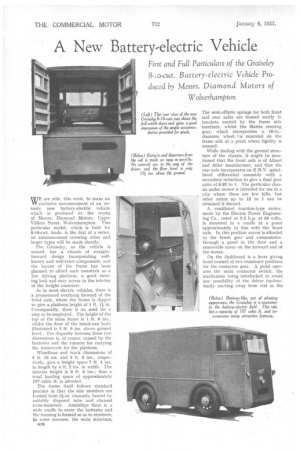A New Battery-electric Vehicle
Page 30

Page 31

If you've noticed an error in this article please click here to report it so we can fix it.
Vrare able, this week, to maxe an xclusive announcement of an entirely new battery-electric vehicle
which is produced at the works of Messrs. Diamond Motors, Upper Villiers Street, Wolverhampton. This particular model, which is built for 8-10-cwt. loads, is the first of a series; an announcement covering other and larger types will be made shortly.
The Graiseley, as the vehicle is named, has a chassis of straight forward design incorporating well known and well-tried components, and the layout of the frame has been planned to afford such essentials as a low driving platform, a good steering lock and easy access to the interior of the freight container.
As in most electric vehicles, there is a pronounced overhang forward of the front axle, where the frame is dipped
to give a platform height of 1 ft. 1/ in. Consequently, there is no need for a
step to be employed. The height of the top of the main frame is 1 ft. 8 ins., whilst the floor of the bread-van body illustrated is 2 ft. 9 ins, above ground level. The disparity between these two dimensions is, of course, caused by the batteries and the runners for carrying the framework for the platform.
Wheelbase and track dimensions of 5 ft. 10 ins, and 3 ft. 8 ins., respec tively, give 'a freight space 7 ft. 4 ins. in length by 4 ft, 2 ins, in width. The interior height is 3 ft. 6 ins.; thus a total loading space of approximately 107 cubic ft. is afforded.
The frame itself follows standard practice in that the side members are formed from 34-in, channels, braced by suitably disposed tube and channel cross-members. Amidships there is a wide cradle to carry the batteries and the framing is formed so as to reinforce, in some measure, the main structure. 616 The semi-elliptic springs for both front and rear axles are housed neatly in brackets carried by the frame side members, whilst the Merles steering gear, which incorporates a 1 6i n . diam eter wheel, is mounted on the frame side at a point where rigidity is assured.
While dealing with the general structure of the chassis, it might be mentioned that the front axle is of Alford and Alder manufacture, and that the rear axle incorporates an E.N.V. spiralbevel differential assembly with a secondary reduction to give a final gear ratio of 8.92 to 1. The particular chassis under review is intended for use in a _ city where there are few hills, but other ratios up to 15 to 1 can be obtained if desired.
A ventilated traction-type motor, made by the Electric Power Engineering Co., rated at 3.5 h.p. at 56 volts, is mounted in a cradle at a point approximately in line with the front axle. In this position access is afforded to the brush gear and commutator, through a panel in the floor and a removable cover on the forward end of the motor.
On the dashboard is a lever giving hand control of two resistance positions for the contactor gear. A pedal operates the main contactor switch, the mechanism being interlocked to avoid any possibility of the driver inadvertently starting away from rest in the " no resistance" notch. A reversing switch giving three positions forward and three in reverse is also situated on the dashboard, and has the usual interlocking device.
The electrical installation includes a meter which shows the condition of the battery, a red hand indicating when it is nearly discharged. Contacts are incorporated at the " full " position for use when recharging with a Westinghouse metal rectifier. In this way the main supply is automatically switched off when the battery is fully charged.
The weight of the chassis works out at 8 cwt., and with a platform body, of the type commonly used by dairies or grocers, the weight of the complete vehicle, for taxation purposes, comes within the 12-cwt. limit (£10 tax). The van, body illustrated, however, is intended for bread delivery, and the vehicle in this case scales rather more than. 13 cwt.
In the ordinary way 60-volt batteries of 162 amp.-hrs. capacity are provided, and it is claimed that the maximum speed on the level is in the region of 16-18 m.p.h., and that the ,machine has a range of 35 miles on one charge. Rather larger batteries (216 amp.-hrs.) are installed on this bread van, so that a somewhat larger range is available than is the case with the standard battery equipment.
The specification alto includes foot and hand brakes operating on all four wheels through the medium of Bendix shoes. The coupling to the pedal arid lever is effected by cable, the drums being 8 ins, in diameter and the shoes 12in. in width: .
As will be gathered from the illustrations,the body is eoachbdilt with Tullwidth doors at the rear, whilst a headlamp, side lamps, an electric windscreen wiper, an electric horn and a safetylass windscreen are included in the specification. A noteworthy item of the tool kit is an hydraulic jack.




























































































